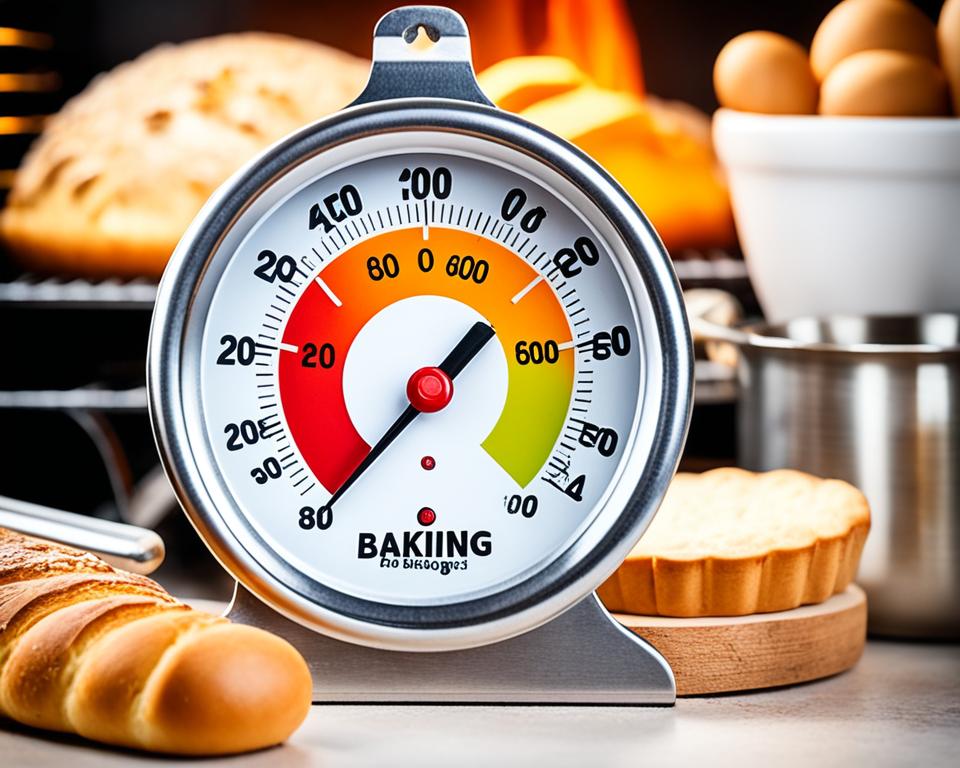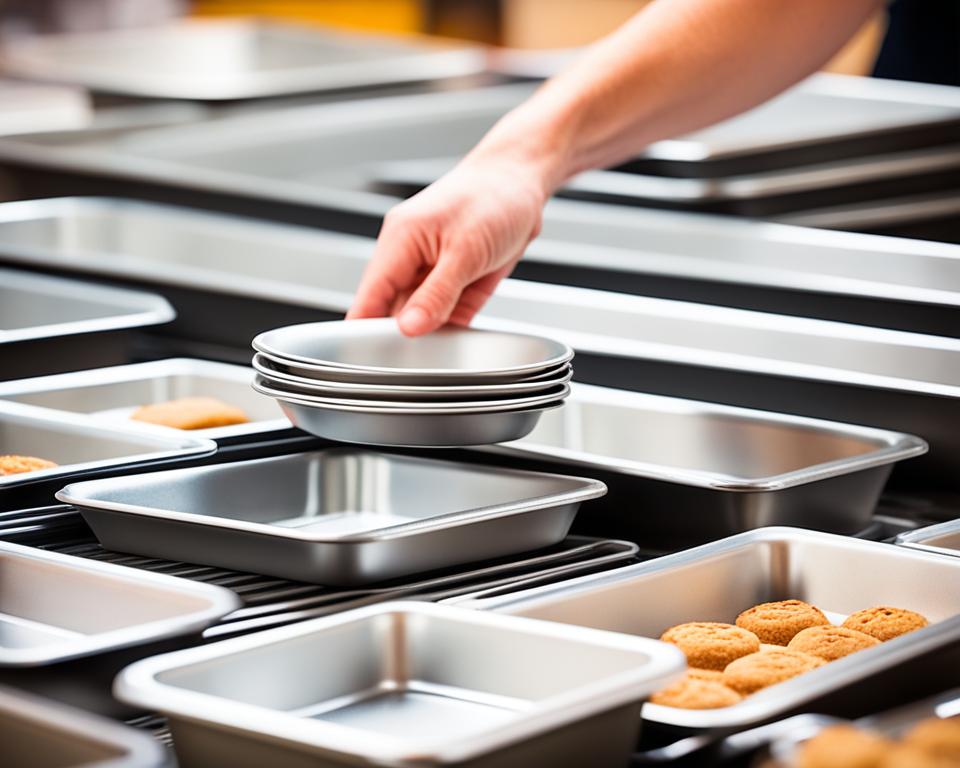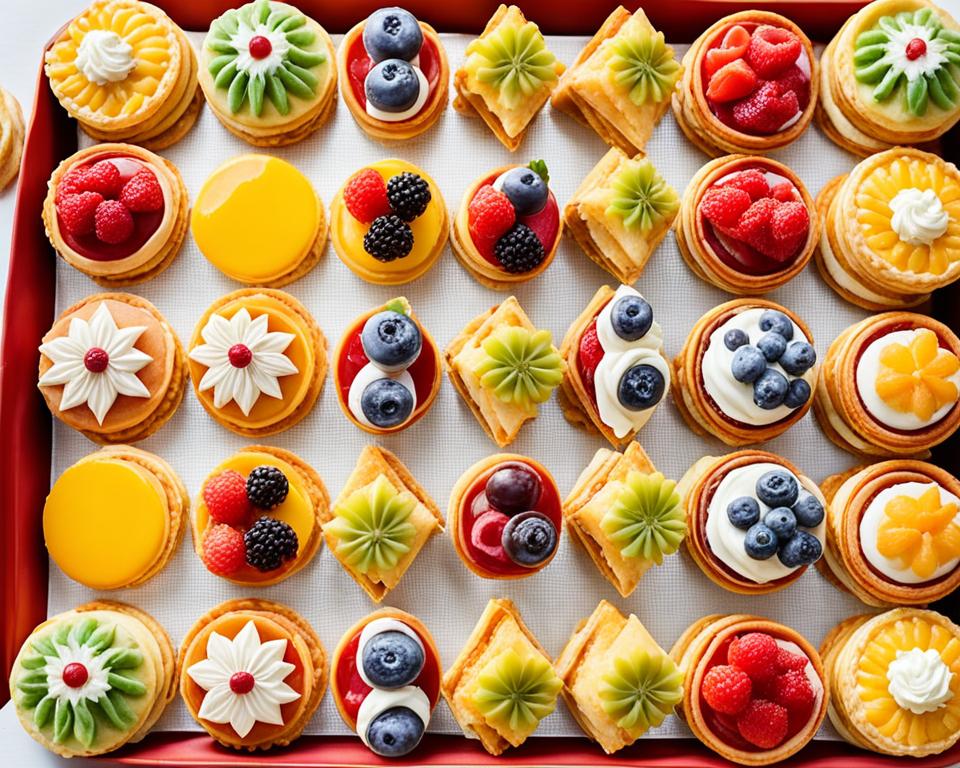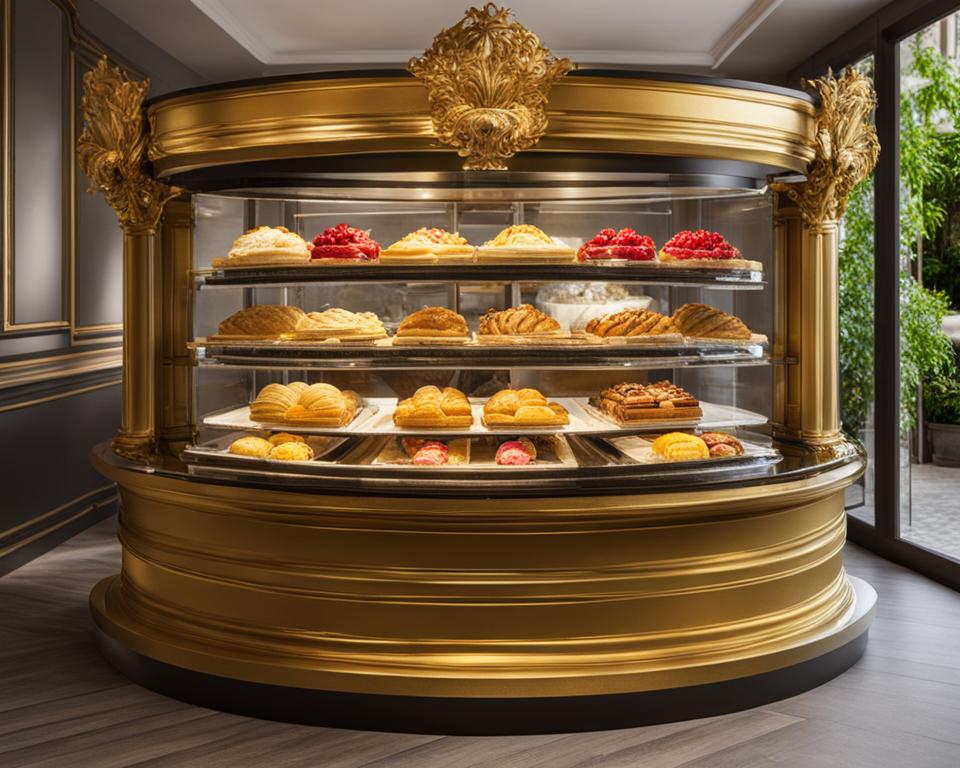Baking can be a delightful and rewarding experience, but for beginners, it can also be daunting. Don’t worry! With the right tips and techniques, anyone can become a confident baker and create mouthwatering treats in their own kitchen.
If you’re new to baking, you’ve come to the right place. In this article, we’ll share some simple tips and tricks that will help you achieve baking success from the very beginning. Whether you’re looking for beginner baking tips, easy baking recipes, or just a little guidance, we’ve got you covered.
Key Takeaways:
- Measure your ingredients accurately for perfect results
- Invest in essential baking tools to make your baking journey easier
- Use room temperature ingredients for even mixing and proper texture
- Ensure accurate oven temperature for consistent baking
- Follow the recipe without making substitutions for consistent results
Measure Properly for Perfect Results
Proper measurement is crucial in baking. To achieve consistent and delicious results, beginners must master the art of measuring ingredients accurately. Follow these essential techniques to ensure your baked goods turn out perfectly every time.
Dry Ingredients:
When measuring dry ingredients such as flour, cocoa powder, or sugar, it’s important to use the spoon and level method. Begin by spooning the dry ingredient into the measuring cup until it overflows slightly. Use the back of a knife or a straight-edge spatula to level off the excess, creating a perfectly level measurement.
Liquid Ingredients:
For liquids, opt for clear measuring cups with volume markers for accurate measurements. Place the measuring cup on a flat surface and pour the liquid while keeping your eyes level with the markings on the cup. This technique ensures proper measurement without any guesswork.
“Precision is key when it comes to baking. Accurate measurements guarantee consistent results and perfectly baked treats.”
Additional Tips:
When measuring flour, avoid packing it into the measuring cup. Instead, lightly spoon the flour into the cup and level it off. Packing flour can lead to a dense and dry final product.
Remember to measure other ingredients carefully as well. Use measuring spoons for smaller quantities like baking powder, baking soda, and spices. Level off these ingredients the same way you would with dry ingredients.
By mastering proper measurement techniques, beginners can conquer the basics of baking and set themselves up for success in the kitchen.
| Ingredient | Measurement |
|---|---|
| All-Purpose Flour | 1 cup |
| Sugar | 1/2 cup |
| Baking Powder | 1 teaspoon |
| Baking Soda | 1/2 teaspoon |
| Salt | 1/4 teaspoon |
Invest in the Right Tools
Having the right tools is essential for beginners to have a successful baking experience. The right tools can make baking easier, more efficient, and more enjoyable. Here are some essential baking tools that every beginner baker should have in their kitchen:
Mixer
A good mixer is a must-have tool for mixing batter and dough. Whether you choose a stand mixer or an electric hand mixer, having a reliable mixer will save you time and effort. It ensures that your ingredients are thoroughly mixed, resulting in a consistent texture and a well-incorporated batter.
Measuring Cups
Accurate measurements are crucial in baking. Investing in a set of measuring cups will ensure that you measure your ingredients precisely. Measuring cups allow you to measure dry ingredients like flour, sugar, and cocoa powder, as well as liquid ingredients like milk and oil.
Mixing Bowls
Having a variety of mixing bowls in different sizes is essential for baking. Mixing bowls are where you’ll combine your ingredients and mix your batter. Look for sturdy, heat-resistant bowls that are easy to clean and can accommodate different quantities of ingredients.
Baking Pans
Choose a selection of high-quality baking pans. These pans come in various sizes and shapes, such as round cake pans, loaf pans, and muffin pans. Investing in non-stick pans will make it easier to remove your baked goods and ensure even baking.
These are just a few of the essential baking tools for beginners. Each tool plays a vital role in achieving baking success. By having the right tools in your kitchen, you’ll be well-equipped to tackle any baking recipe and enjoy the process of creating delicious homemade treats.
| Essential Baking Tools for Beginners: | |
|---|---|
| Mixer | A stand mixer or an electric hand mixer |
| Measuring Cups | For precise measurement of dry and liquid ingredients |
| Mixing Bowls | In various sizes for mixing and combining ingredients |
| Baking Pans | Non-stick pans in different sizes and shapes |
Use Room Temperature Ingredients
Using room temperature ingredients is essential for beginner-friendly baking and ensures even mixing and proper texture in your baked goods. When your ingredients are at the same temperature, they combine more easily, resulting in a smoother batter and more evenly baked treats.
Before starting your recipe, make sure that your butter and eggs are at room temperature. Room temperature butter is soft and pliable, allowing it to mix more evenly into the other ingredients. To bring butter to room temperature quickly, cut it into small pieces and leave it at room temperature for about 30 minutes, or you can microwave it at low power in short intervals until it softens.
Besides butter, room temperature eggs are also important. Eggs blend better at room temperature and are easier to incorporate into the batter, which leads to a lighter and more tender crumb. To bring eggs to room temperature quickly, place them in a bowl of warm water for about 5-10 minutes.
Quick Tips for Achieving Room Temperature Ingredients:
- For butter, cut it into small pieces and leave it at room temperature for about 30 minutes, or microwave it at low power in short intervals until softened.
- To bring eggs to room temperature quickly, place them in a bowl of warm water for about 5-10 minutes.
Table: Tips for Achieving Room Temperature Ingredients
| Ingredient | Method |
|---|---|
| Butter | Cut into small pieces and leave at room temperature for about 30 minutes |
| Eggs | Place in a bowl of warm water for about 5-10 minutes |
Ensure Accurate Oven Temperature
When it comes to baking, ensuring that your oven is at the correct temperature is essential for achieving successful results. An inaccurate oven temperature can lead to undercooked or overcooked baked goods, affecting both their texture and taste. Hence, it is crucial for beginners to pay attention to oven temperature to avoid disappointment in their baking endeavors.
To ensure accuracy, it is recommended to periodically check your oven’s temperature with an oven thermometer. These thermometers are readily available in kitchen stores and online. Simply place the thermometer inside the oven and compare its reading to the temperature set on your oven’s dial or display. If there is a significant difference, you may need to calibrate or adjust your oven accordingly to maintain accuracy.
Additionally, it is important to minimize opening the oven door while baking. Opening the door allows heat to escape, causing fluctuations in temperature and potentially affecting the baking process. Instead, use the oven light and rely on the recommended baking times and visual cues provided in the recipe to determine doneness.
“Maintaining the accurate oven temperature is like having a reliable partner in your baking journey. It ensures your baked goods rise, brown, and bake evenly, allowing you to achieve the perfect results every time.” – Renowned Baker
Remember, patience and precision are key when it comes to baking. By ensuring accurate oven temperature, beginners can set themselves up for success and confidently create delightful treats in their home kitchens.

| Baking Techniques | How to Bake for Beginners |
|---|---|
| Measure Properly | Invest in the Right Tools |
| Use Room Temperature Ingredients | Ensure Accurate Oven Temperature |
| Follow the Recipe, No Substitutions | Mix with Care |
| Understand Leavening Agents | Properly Prepare Baking Pans |
| Measure Batter Evenly for Uniform Results |
Follow the Recipe, No Substitutions
Baking is a science, and following the recipe is essential for achieving consistent and delicious results. While it may be tempting to make substitutions based on personal preference or ingredient availability, doing so can lead to unexpected outcomes. For beginner bakers, it’s especially important to adhere to the recipe as closely as possible to learn and understand the fundamental techniques of baking.
When it comes to key ingredients like flour, sugar, butter, and eggs, it’s best to avoid any substitutions. These ingredients play crucial roles in the texture, structure, and flavor of baked goods. Deviating from the recipe may result in a different and potentially undesirable outcome.
However, there are instances where minor substitutions can be made without significantly affecting the recipe. For example, adding nuts or swapping out one type of zest for another can add a personal touch to the finished product. Just ensure that the substitute ingredient has a similar flavor profile, texture, and moisture content to maintain the overall integrity of the recipe.
Key Takeaways:
- Follow the recipe closely to achieve consistent and desirable baking results.
- Avoid making substitutions for key ingredients like flour, sugar, butter, and eggs.
- Minor substitutions, such as adding nuts or swapping zest, can be made without major consequences.
Remember, baking is both an art and a science. As you gain more experience and confidence, you can begin to experiment with substitutions and modifications. But for now, focusing on mastering the basics and building a foundation of reliable recipes will help you become a skilled baker.
| Ingredients | Substitutions |
|---|---|
| All-purpose flour | Avoid substituting with alternative flours as it may affect the texture and structure of baked goods. |
| Granulated sugar | Substitute with brown sugar for a slightly different flavor profile. |
| Butter | Substitute with margarine or vegetable shortening, keeping in mind that the texture and flavor may differ. |
| Eggs | Vegetable oil, unsweetened applesauce, or mashed bananas can be used as egg substitutes in some recipes, but it’s best to follow an eggless recipe for guaranteed results. |
Mix with Care
When it comes to achieving perfect results in baking, it’s crucial to mix the batter with care. Overmixing can lead to tough and chewy baked goods, which is certainly not what we want. To ensure tender and delicious treats, it’s important to know the proper mixing techniques.
“Mixing the batter only until it is combined and no more is the key to success.”
Different terms like beat, blend, and mix are often used in baking recipes, but what do they really mean? Let’s break it down:
- Beat: This term indicates a vigorous and continuous motion, often used when incorporating air into the batter, such as when whipping egg whites or cream.
- Blend: Blending involves gently combining ingredients until they are evenly distributed. It’s a slower and more careful process.
- Mix: Mixing refers to combining the ingredients until they come together, with no streaks or clumps remaining. It’s important to avoid overmixing, as this can result in dense and heavy baked goods.
Remember, each recipe will specify the appropriate mixing method and duration. Following these instructions will help you achieve the desired texture and consistency in your baked treats.
| Mixing Technique | Description |
|---|---|
| Beat | Vigorous and continuous motion; incorporates air into the batter |
| Blend | Gently combines ingredients until evenly distributed |
| Mix | Combines ingredients until they come together without streaks or clumps |
Understand Leavening Agents
Baking powder and baking soda are essential leavening agents in baking. These ingredients play a crucial role in achieving the desired rise and texture in baked goods. As a beginner baker, it’s important to understand the difference between baking powder and baking soda and when to use each one.
Baking powder contains a combination of an acid (like cream of tartar) and a base (like baking soda). When mixed with a liquid and exposed to heat, baking powder produces carbon dioxide gas, causing the batter or dough to rise. It is commonly used in recipes that do not have acidic ingredients.
Baking soda, on the other hand, is a base that requires an acidic ingredient (like buttermilk, yogurt, or vinegar) in the recipe to react. When combined with the acid, baking soda releases carbon dioxide gas, resulting in a rise. It is best used in recipes that already contain acidic ingredients.
| Baking Powder | Baking Soda |
|---|---|
| Contains both an acid and a base. | A base that requires an acidic ingredient. |
| Generally used in recipes without acidic ingredients. | Typically used in recipes with acidic ingredients. |
| Does not require additional acidic ingredients in the recipe. | Requires acidic ingredients to react properly. |
| Can provide a more balanced rise. | May result in a slightly tangy taste if not balanced with enough acidity. |
It’s crucial to follow the recipe’s instructions when it comes to using baking powder or baking soda. Using the wrong leavening agent can severely impact the final result of your baked goods. Always check for the specific ingredient measurements and baking techniques appropriate for each leavening agent.
Now that you understand the role of baking powder and baking soda, you can confidently incorporate these leavening agents into your baking adventures. Experiment with different recipes and enjoy the delightful rise and texture achieved through proper understanding and usage of leavening agents.
Properly Prepare Baking Pans
Properly preparing baking pans is an essential step in baking to ensure that your delicious creations don’t stick and are easy to remove. By using the right techniques and tools, you can achieve the perfect bake every time. Here are some beginner baking essentials for preparing baking pans:
1. Parchment Paper
Using parchment paper is a convenient and foolproof way to prevent sticking. Simply line your baking pan with parchment paper before adding the batter or dough. The non-stick surface of the parchment paper allows for easy release and quick cleanup.
2. Silicone Mats
Silicone baking mats are another fantastic option for preparing baking pans. These reusable mats provide a non-stick surface and are heat-resistant, making them ideal for all your baking needs. Just place the mat on your baking pan, add the batter, and enjoy hassle-free baking.
3. Nonstick Spray with Flour
A spray that combines nonstick properties with a dusting of flour can be a game-changer when it comes to preparing baking pans. With just a quick spritz, you can ensure that your baked goods effortlessly release from the pan, leaving behind no residue.
| Pros | Cons |
|---|---|
| Convenient and easy to use | Additional cost |
| Prevents sticking and promotes even baking | Can alter the texture of certain baked goods |
| Provides consistent results | May contain additives |
Remember, when using any of these methods, it’s important to follow the recipe instructions for greasing or lining the pan. Different recipes may require different preparations to achieve the best results. Ensure that the prepared pan is distributed evenly for uniform baking and appearance.

Properly preparing your baking pans is a vital part of the baking process, ensuring that your creations turn out perfectly every time. By using parchment paper, silicone mats, or nonstick spray with flour, you’ll have no trouble releasing your baked goods from the pan, allowing them to truly shine.
Measure Batter Evenly for Uniform Results
When it comes to baking, achieving consistent and uniform results is key. One important aspect of this is measuring the batter evenly. Unevenly measured batter can lead to variations in size, texture, and bake time of your baked goods. To ensure that your cookies, muffins, and cupcakes turn out perfectly every time, consider using cookie scoops and ice cream scoops with triggers.
Cookie scoops are handy tools that allow you to scoop up a consistent amount of batter and deposit it onto your baking sheet. These scoops come in various sizes, allowing you to choose the desired portion for your cookies. Not only do cookie scoops help measure the batter evenly, but they also shape the dough into neat, round portions. This results in cookies that spread evenly and bake uniformly.
Ice cream scoops with triggers are another great option for measuring batter. These scoops work similarly to cookie scoops but are larger in size, making them perfect for muffins and cupcakes. Their triggers make it easy to release the batter into muffin tins or cupcake liners, ensuring consistent portioning and reducing mess.
By using these scoops, you can eliminate the guesswork and achieve uniform results every time. No more unevenly sized cookies or muffins that bake unevenly. With the help of cookie scoops and ice cream scoops with triggers, your baked goods will look and taste professional.
Here’s a table summarizing the benefits of using cookie scoops and ice cream scoops with triggers:
| Benefits | Cookie Scoops | Ice Cream Scoops with Triggers |
|---|---|---|
| Consistent Measurement | ✅ | ✅ |
| Uniform Shape | ✅ | ✅ |
| Better Presentation | ✅ | ✅ |
| Less Mess | ✅ | ✅ |
Using these scoops not only helps beginners in their baking endeavors but also saves time and effort in the kitchen. So, next time you’re baking, reach for a cookie scoop or an ice cream scoop with a trigger to measure your batter evenly and achieve those beautifully uniform results.
Conclusion
Baking can be a rewarding and enjoyable experience, even for beginners. By implementing these beginner baking tips and techniques, anyone can achieve baking success and create delicious treats in their own kitchens.
First and foremost, it’s essential to measure ingredients properly to ensure perfect results. Using the spoon and level method for dry ingredients and clear measuring cups for liquids guarantees accuracy in your recipes. Additionally, investing in the right tools, such as a good mixer and essential baking equipment, will make the baking process easier and more enjoyable.
Remember to use room temperature ingredients for even mixing and texture in your baked goods. Taking the time to bring butter and eggs to room temperature before using them in your recipes can make a significant difference. Additionally, ensuring accurate oven temperature is crucial. Regularly check your oven with an oven thermometer to maintain consistency throughout the baking process.
Following recipes without substitutions is also key to success in baking. Baking is a science, and any alterations can lead to inconsistent results. While minor substitutions can be made, it’s best to stick to the original recipe when it comes to key ingredients like flour, sugar, butter, and eggs.
Proper mixing techniques and understanding leavening agents are vital in achieving desirable texture and rise in baked goods. Avoid overmixing to prevent tough and chewy treats. Lastly, properly preparing your baking pans ensures easy removal of your creations.
By incorporating these beginner baking tips into your baking routine, you’ll gain confidence and create impressive baked goods. With practice and a little patience, you’ll be on your way to becoming a baking pro. So, grab your apron, preheat that oven, and start creating delicious treats in your own kitchen. Happy baking!
FAQ
What are some tips for baking success for beginners?
Some tips for baking success for beginners include measuring properly, investing in the right tools, using room temperature ingredients, ensuring accurate oven temperature, following the recipe without substitutions, mixing with care, understanding leavening agents, properly preparing baking pans, and measuring batter evenly.
How should dry ingredients be measured?
Dry ingredients should be measured using the spoon and level method, which involves spooning the ingredient into the measuring cup and leveling off the excess with a straight edge.
How should liquid ingredients be measured?
Liquid ingredients should be measured using clear measuring cups with measurement markings on the side. They should be poured into the measuring cup and viewed at eye level to ensure accuracy.
What are some essential baking tools for beginners?
Some essential baking tools for beginners include a good mixer, measuring cups, mixing bowls, and baking pans.
Why is it important to use room temperature ingredients?
Room temperature ingredients mix more evenly and create a better texture in baked goods. Butter and eggs should be brought to room temperature before using them in a recipe.
How can I quickly bring ingredients to room temperature?
To quickly bring butter to room temperature, cut it into small pieces and leave it out for about 30 minutes. To bring eggs to room temperature, place them in a bowl of warm water for about 10 minutes.
How can I ensure that my oven is at the correct temperature?
You can ensure that your oven is at the correct temperature by periodically checking it with an oven thermometer. If it is not accurate, you may need to adjust the temperature accordingly.
Can I make substitutions in baking recipes?
It is generally best to follow the recipe as closely as possible and avoid making substitutions, especially for key ingredients like flour, sugar, butter, and eggs. However, minor substitutions like adding nuts or swapping zest can be made without affecting the recipe.
How should batter be mixed?
Batter should be mixed only until it is combined and no more. Overmixing can lead to tough and chewy baked goods. Different terms like beat, blend, and mix indicate the desired mixing technique for each recipe.
What are the differences between baking powder and baking soda?
Baking powder and baking soda are both leavening agents used in baking, but they have different roles. Baking powder contains both an acid and a base and is used in recipes that do not have acidic ingredients. Baking soda, on the other hand, is used in recipes that have acidic ingredients and requires an acidic element to activate it.
How can I properly prepare baking pans?
Baking pans can be prepared by using options like parchment paper, silicone mats, or nonstick spray with flour. These methods help prevent baked goods from sticking and make them easier to remove from the pans.
How can I measure batter evenly?
Using cookie scoops or ice cream scoops with triggers helps to ensure that batter is measured evenly, leading to consistent and uniform results in cookies, muffins, and cupcakes.
How can beginners achieve baking success?
Beginners can achieve baking success by following these simple tips and techniques consistently and practicing their baking skills with a little patience. With time, they will gain confidence in the kitchen and be able to create delicious treats with ease.




